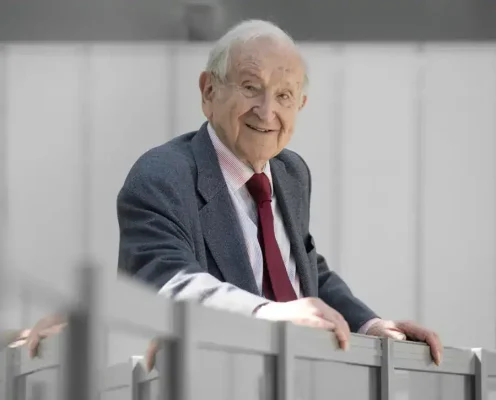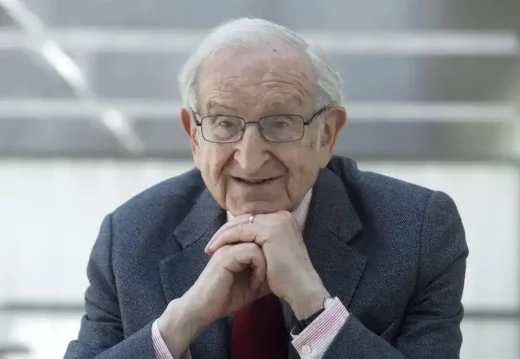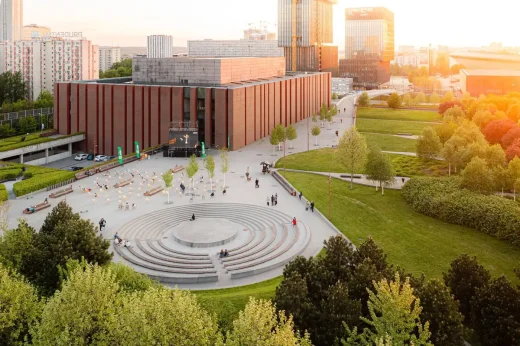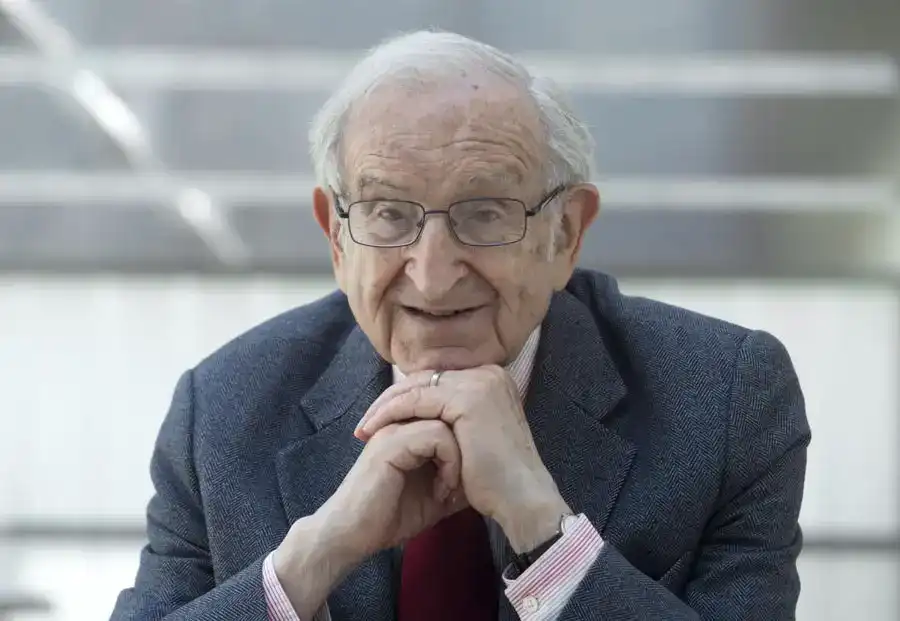Joseph Rykwert architecture writer, Architectural critic, Building historian theory
Joseph Rykwert: Architecture Critic
Contemporary Architectural Theory
post updated 13 December 2024
In Memoriam: The Passing of Joseph Rykwert, Eminent Historian, Critic, and Leader of CICA
Born in Warsaw, in 1926, Joseph Rykwert was one of the leading architectural historians and critics of his generation. He travelled to the United Kingdom on the eve of Second World War, where he studied at the Bartlett and Architectural Association.
England became the center of his professional activities after a brief stage at the Ulm School of Design. He taught at the Royal College of Art, the University of Essex, and at Cambridge University as Slade Professor of Fine Arts and Reader in Architecture.
Joseph Rykwert architectural critic:

photograph : Pawel Mazurl CC Krakow
In 1988 he was appointed the Paul Philippe Cret Professor of Architecture at the University of Pennsylvania; he became Emeritus Professor in 1998. He was also a visiting professor at numerous key architecture schools such as Princeton, Harvard, New York University, The Cooper Union, and the Institut d’Urbanisme of Paris, amongst others.
He was awarded Honorary Degrees from such universities as Edinburgh, Bath, Rome, Bologna, Trieste and Córdoba in Argentina. He was a Member of the Academia di San Luca. Amongst his many prizes is the RIBA Royal Gold Medal in 2014, on which occasion he delivered a memorable lecture entitled “Architecture, a Profession or an Art”.
Previously on e-architect:
Joseph Rykwert : Winner of the Royal Gold Medal for architecture for 2014
Tuesday 25 February 2014
Joseph Rykwert receives the 2014 Royal Gold Medal for architecture
26 + 25 Feb 2015
Joseph Rykwert Wins Royal Gold Medal
Joseph Rykwert is a world-leading authority on the history of art and architecture; his groundbreaking ideas and work have had a major impact on the thinking of architects and designers since the 1960s and continue to do so to this day.
His seminal book The Idea of a Town (1963) remains the pivotal text on understanding why and how cities were and can be formed. He has written numerous influential works of architectural criticism and history, published over a sixty-year period and translated into several languages. The most significant of these are On Adam’s House in Paradise (1972), The First Moderns (1980), The Necessity of Artifice (1982), The Dancing Column: On Order in Architecture (1996), and The Seduction of Place (2002); all have changed the way modern architects and planners think about cities and buildings, and how historians view the architectural roots of the modern era.
Rykwert’s works have influenced generations of architects with many either having been taught by him directly or taught in a school where his influence has had a profound effect on a department’s teaching. Distinguished architects David Chipperfield, Frank Gehry and Renzo Piano are amongst the previous Royal Gold Medallists who have personally supported Joseph’s nomination.
18 Sep 2013
Joseph Rykwert News
The Winner of the Royal Gold Medal for architecture for 2014
Joseph Rykwert to receive the 2014 Royal Gold Medal for architecture
The celebrated architectural critic, historian and writer Joseph Rykwert has been named as the recipient of the 2014 RIBA Royal Gold Medal, one of the world’s most prestigious architecture awards.
RIBA President Stephen Hodder said today,
“The recognition of Joseph with this prestigious award is long overdue; that it has gone to a man whose writings have provided inspiration to so many who practice in the heart of our cities, gives me particular personal pleasure. Joseph’s writing and teaching are rare in that he can deliver the most profound thinking on architecture in an accessible way. All our lives are the richer for it.”
Born in Warsaw in 1926, Joseph Rykwert is a naturalized British citizen. He has held a number of university teaching posts in Britain and the United States. He is currently Paul Philippe Cret Professor of Architecture Emeritus and was Professor of Art History at the University of Pennsylvania.
Joseph Rykwert has lectured or taught at most of the world’s major schools of architecture and has held visiting appointments at Princeton, the Cooper Union, New York, Harvard Graduate School of Design, the University of Sydney, Louvain, the Institut d’Urbanisme, Paris, the Central European University and others. He has held fellowships at the Center for Advanced Studies in the Visual Arts, Washington and the Getty Center for the History of Art and the Humanities.
In 1984, he was appointed Chevalier dans l’ordre des Arts et des Lettres. He holds honorary degrees from the University of Edinburgh, the University of Cordoba, Argentina, the University of Bath, Toronto and Trieste and Rome, and is a member of the Italian Accademia di San Luca and the Polish Academy. In 2000, he was awarded the Bruno Zevi prize in architectural history by the Biennale of Venice and in 2009 the Gold Medal Bellas Artes, Madrid. He has been president of the international council of architectural critics (CICA) since 1996.
Joseph Rykwert historian and architectural critic:

photograph : Pawel Mazurl CC Krakow
He joins previous theorists and largely non-practitioners to have been honoured with the Royal Gold Medal including Colin Rowe (1995), Sir John Summerson (1976) and Sir Nikolaus Pevsner (1967).
Joseph Rykwert will be presented with the 2014 Royal Gold Medal at a special event at the RIBA at 66 Portland Place, London W1 on the 25 February 2014.
The 2013 RIBA Honours Committee who selected Joseph Rykwert was chaired by RIBA President Stephen Hodder with Sir David Chipperfield, Louisa Hutton, Eric Parry and Frederic Migayrou.
+++
Joseph Rykwert Award Citation
Citation to Joseph Rykwert by Eric Parry
Now in his eighty-seventh year Joseph Rykwert’s body of published work is by any standard extraordinary in its consistent intensity, relevance and on-going influence. We too easily take for granted the way in which he has enriched of today’s debate about our environment when confronted by the span of his career. In 1949 he was introduced by Sigfried Giedion to the president of CIAM, Cornelis van Eesteren at their seventh gathering in Bergamo as ‘our young revolutionary’. Of the five or so historian / theorists to have received this award since WW II Giedion’s name is conspicuous by its absence.
Whilst Joseph’s reputation places him in the camp of the builders of architects rather than that of the designer of buildings he is at heart an architect. He began his training at The Bartlett in 1942, at that time evacuated to Cambridge, then moved to the AA, worked for Maxwell Fry and Jane Drew, followed by time spent with Richard Sheppard and then Ove Arup. Later he designed together with Mark Livingston a housing development at Inner Court, Old Church Street, London, which was recently reviewed for listing and received considerable local and national support against demolition and so quite naturally, next to his writing desk he has always maintained a drawing board.
Joseph’s principal books have changed the way architects, planners and urban theorists think about buildings and cities and more fundamentally how historians view the architectural roots of our era. The first manifestation, after a fascinating intellectual journey was The Idea of a Town in 1963. He conceived it at a time when product design and empirical sociology were thought to offer the solutions needed to solve the problems which re-building after the destruction of the war required.
It was a critical response to the picturesque ideas of the Townscape movement; the formal preoccupations of both the Brutalists and the techno-utopians; and the anarchic cries for the dismantling of the industrial city by groups like the Situationists. In The Idea of a Town he drew together two critical strands of investigation, that of the social, political and artistic history of the Italian town (so often cites as a precedent by practitioners and theorists) together with an anthropological investigation of how society related to the fabric which it created and was subsequently conditioned by it. On Adam’s House in Paradise followed nine years later in 1972.
Eight years later in 1980 the weightier The First Moderns brought a radical freshness to the well-trodden paths of 17th and 18th Century architectural scholarship. It represented in part the fruit of thirteen very influential years as Professor of Art at Essex University. The post-graduate seminar on the history and theory of Architecture that he began there in 1967/8 was the first of its kind anywhere and it is harrowing to reflect that the architectural authorities of the time wanted it suppressed.
Frances Yates, one of the most distinguished scholars then teaching at the Warburg Institute Warburg, praised The First Moderns lavishly. “The range of Rykwert’s learning is enormous. History of gardens, Chinese influences, festival architecture, all contribute to the overflowing wealth. Great figures in the history of thought and science — Bacon, Newton, Vico — are seen from new angles…This is no superficial history of styles, no conventional history of ideas. It invigorates both through the attempt at a new kind of history of architecture.”
Amongst those who figure in the acknowledgements for The First Moderns are some of his students Yoshihige Akahosi, David Leatherbarrow, Solomon Kaufman, Mohsen Mostafavi and Alberto Perez Gomez. Their subsequent careers, and many, many others, are witness to the fertile ground he helped to create for them. As a demonstration of that range which Frances Yates remarked on, in 1982 he published The Necessity of Artifice which drew together 18 previous essays spread over a period of twenty five years. They all sparkle with the common ground of his perceptive analysis of the human condition and of individual creativity.
Of the former The Sitting Position – A Question of Method and Learning from the Street are memorable examples whilst his essay Two Houses by Eileen Gray (the first publication about her work after Corbusier’s book Des Canons, des Munitions? Merci!Des Logis…SVP) in 1937 and Adolf Loos: The New Vision were groundbreaking. Joseph made his first trip to Italy, a country and culture that has gripped him ever since then, with John Turner with whom he shared both an architectural and political affinity, John Turner who would later publish the influential Freedom to Build 1972. Apart from the thrill of the best contemporary design, and an easy contact with a host of important figures it was, as he has put it, “the unexpected grandeur of S Andrea Mantua that conquered me entirely on that first visit.” It led to a series of collaborative projects, translations, commentaries and advocacy of Alberti’s greatness. In 1988 he published a translation, undertaken with Neil Leach and Robert Tavernor, On the Art of Building in Ten Books. Following this in 1994 he curated with his wife Anne and Robert Tavernor the major exhibition of Alberti’s life and work, held in the Palazzo Te Mantua.
A larger space of time separates The First Moderns from The Dancing Column: On Order in Architecture published in 1996. During the intervening period Joseph moved from the University of Essex to the University of Cambridge, where in 1979 he had delivered the Slade lectures. In 1988 he was appointed Paul Philippe Cret Professor at the University of Pennsylvania which he held until 1999. If On Adam’s House was in a sense a response to the wide breadth and scope of The Idea of a Town, so The Dancing Column is to The First Moderns.
In the former he examined the Western world’s changing attitudes towards the Classical orders since antiquity. In the latter he examined the growth of the associations of the words ‘classic’ and ‘classical’ as they apply to architecture, through the ground of revolution, objectivity, enlightenment and equality. The Dancing Column has been widely acclaimed, Frank Gehry calls the work ‘staggering’, claiming: ‘I can’t stop reading it’, whilst leading academics were similarly impressed. Frank Gehry is one of no less than seven previous Gold Medalists who supported his nomination. In 2002 he was presented with a festschrift entitled Body and Building: essaying on the changing relationship of body to architecture – edited by George Dodds and Robert Tavernor. It contains twenty essays contributed by scholars, close associates and former students and raises issues that have been a constant concern of Rykwert’s.
The Europe we know is a relatively stable political entity. 2012 marked the fiftieth anniversary of the Franco-German reconciliation signed by Chancellor Adenauer and President de Gaulle. The political context of Joseph’s youth could not have been more different. Warsaw was the epicentre of the growing political storm in the 1930s.
With a maternal lineage referencing pre-revolutionary Russia as a cultural precedent and an anglophile father, Joseph vividly recalls his family’s nervous laughter at the menacingly comical broadcasts of one Adolf Hitler and at the same time the living terror experienced at first hand by his father of communist Russia. He coped admirably well, seeds sown at Charterhouse School succored by the dazzling intellectual firmament of the Warburg and thereafter very much on a path of his own making.
Joseph’s first review, that of Siegfried Giedion’s Mechanization Takes Command, published in 1948 took him two years to complete, no doubt drawn out by the need to have fully grasped the material. That same tenacity and wisdom underlies all his work. Let the last words of this citation be Susan Sontag’s: “Joseph Rykwert is a gloriously erudite ingeniously speculative historian and critic of architecture – of that is, the forms (in the most concrete sense) of civilization, of social embodiment itself.”
Joseph Rykwert Background
Joseph Rykwert was born in 1926 in Warsaw, Poland, He moved to England in 1939.
He is Paul Philippe Cret Professor of Architecture Emeritus at the University of Pennsylvania, and is widely regarded as the most important architectural historian and critic of his generation. He has spent most of his working life in the UK and USA.
Joseph Rykwert is the author of many influential works of architectural criticism and history. The most important of these are:-
The Idea of a Town (1963)
On Adam’s House in Paradise (1972)
The Dancing Column (1996)
The Seduction of Place (2000)
All his books have been translated into several languages.
More information about Joseph Rykwert online soon
Location: London, England, United Kingdom
+++
Polish Building Designs
Polish Architecture Designs – chronological list
Polish Architectural News
The Polish History Museum, Warsaw
Architects: WXCA

photo : WXCA_Daniel Ciesielski
Polish History Museum in Warsaw Building
Metropolitan Station, Lublin
Design: Tremend Studio

photo : Rafal Chojnacki
New Metropolitan Station Lublin
National Polish Radio Symphony Orchestra Headquarters, Katowice, Silesian Voivodeship, southern Poland
Architecture: Konior Studio

photograph : Radosław Kaźmierczak
NOSPR headquarters Katowice
Joseph Rykwert Information
Joseph Rykwert was based between the UK and the USA
Architecture Design
Contemporary Building Designs – recent architectural selection from e-architect below:
Buildings / photos for the Joseph Rykwert page welcome





